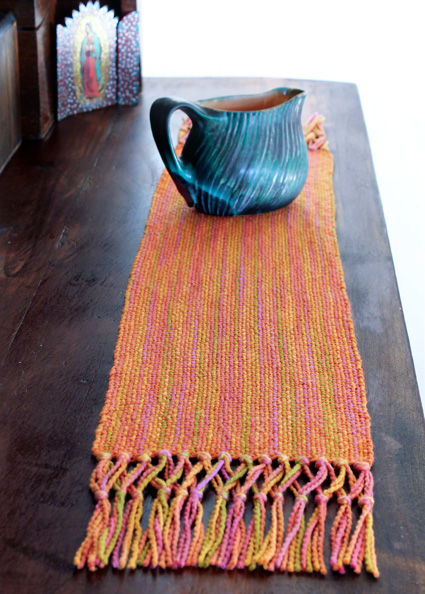

|
|
||
|
||
 by Liz Gipson | ||
|
SIZE |
|
FINISHED MEASUREMENTS (laid flat) |
|
MATERIALS Project specifications
|
|
PATTERN NOTES |
|
If you are unhappy with the drape of your fabric, it is probably because you are packing the weft yarns too tight and not leaving enough space between your yarns. They need room to bloom! A table runner/scarf is a good first project because you aren't looking for drape so if you overbeat it, it won't affect the final result. It is a perfect, quick gift project that will burn through your stash. |
|
DIRECTIONS Center the warp in the rigid heddle for 7 inches. Using the direct warping method, thread 7 inches worth of slots. Wind the warp on the back beam adding packing paper between the layers. Move one thread in each slot to a hole to its left. Tie the warp on the front apron rod and adjust for even tension. WeavingWind 2 shuttles, one with a smooth scrap yarn, and the other with your weft yarn. To give yourself a good foundation and to spread the warp, start by weaving a piece about 1.5 inches long with scrap yarn. It doesn't matter if you start in an up or down shed. Using your project weft, open the next shed and insert your first pick leaving a tail of about 6 inches. Change sheds, tuck the tail in the new shed and then bring it out between two warp ends. Lay in the next pick at about a 60 degree angle and beat (see top photo at right). Continuing weaving, as you do maintain your weft angle. This will allow the weft enough room to travel over and under the warp ends and keep your fabric from pulling in at the edges. If you have loops at the edges, called selvedges, your weft angle is too steep, Beat the yarn gently as you weave to maintain a consistent number of wefts per inch. (See middle photo.) Your goal is to get the same number of warp and weft ends in an inch of weaving. Don't over think this, though. The goal is to get a few projects under your belt, not perfection! Remove Cloth from Loom FINISHING Work from whichever direction is comfortable for you. In this scenario I'm working from left to right. Like many things yarn, this is easier to do than comprehend. Split the first three bundles in half.
Starting with the first bundle, lay the right half of this bundle under the right half of the second bundle and over the left half of third bundle
When doing so make sure that third bundle's right half goes over the right half of the second bundle. Tie a knot at place where the first bundle's left half meets the left half of the second bundle. Tie the next knot where the left half of the first bundle meets the right half of the third bundle.
Continue working in this manner across the fringe. Tighten and adjust knots to align with one another as necessary.
Washing This basic form can be used to create an endless variety of projects -- lengthen the warp and you have a scarf, widen and lengthen the warp and you have a shawl. In this column, we have the first steps in cloth design -- yarn selection and sett. In the next installment, we will talk about color and working with unalanced weaves. In the meantime, join me on any of the Yarnworker social media sites (see links below) and show off your cloth! |
| ABOUT THE DESIGNER |
Liz Gipson is a lover of yarn and that from which it comes -- namely the mills and fiber-bearing critters and plants. She is the author of the newly revised Weaving Made Easy and has two DVDs Slots and Holes: Three Ways to Warp a Rigid-Heddle Loom and Life After Warping: Weaving Well on your Rigid-Heddle Loom She recently lanched Yarnworker, a source for indepentantly published patterns and know-how for the rigid-heddle loom. |
Text & images © 2015 Liz Gipson. Contact Liz |